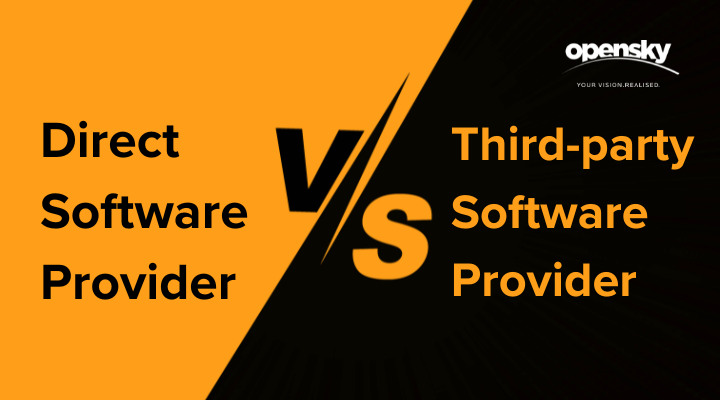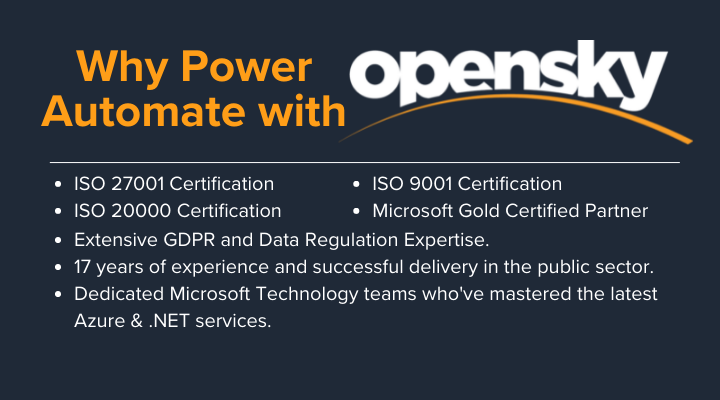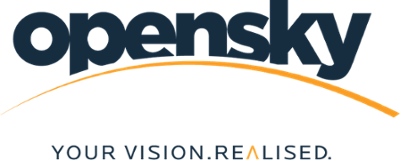Direct vendor vs third party: how to pick the best automation partner
What are the benefits of getting automation solutions from a direct provider vs a third-party provider? Which is better? And how do I plan my automation project? In this article, we explore all these questions and more, to empower your Automation project decisions.

Despite the advent of low-code and no-code automation, choosing how to build and deploy your automation project is as difficult as ever. The technology changes, but the factors affecting it don't: budget constraints, limited resources, and tight deadlines make picking an automation strategy a serious consideration that deserves time and thought. You have one chance to automate your business processes, with little in the way of budget for do-overs – so you have to make sure your automation project is perfectly planned out.
So how do you pick the best partner who will deliver high quality automation that perfectly fits your organisation's requirements and objectives? Well, you have two options: a third-party provider, or the direct provider of the automation software in question. What are the pros and cons of these different automation providers? Let's take a look.

What to consider when picking an automation partner
Picking an automation provider? There are a few questions you need to ask first.
1. What are your processes, goals, and objectives in the long term?
This is the heart of your automation decision; what you want to do with automation will likely decide who your chosen provider should to you. If your business processes and goals are relatively common, or as simple as connecting email, databases, and reporting dashboards, then a direct solution will work well. But if you want to plug in different new software into old databases and legacy web portals to produce automatic reports and allow team members to get automatic workflows based on user actions (and other such multi-step, complex processes) then you need the specialised attention of a third-party bespoke solution provider.
2. How much access and custom tailoring will you need from your automation software and programming?
There is a world of difference between the support and custom tailoring you get from a large, multi-billion-dollar direct vendor and that which you'd get from a smaller, leaner third party.
Large proprietary software and tech solutions from direct vendors have nearly completely locked down their source code, making it impossible for you to customise this software yourself. If there is some extension or functionality you desperately need, it might take months (or even years) to have it build (especially if your desired functionality is for a niche industry use case).
What's more, your use of this enterprise software is tied to a continuing license or contract, especially as the digital landscape increasingly embraces Software as a Service. For this software, vendor support is the only real option. If automation flexibility is a must, third-party providers need to be considered at the procurement stage.
3. What will your contract look like in 3 years?
Freedom and the restrictions of your contract are something you should consider in your cost and partner analysis. While it might be cheaper to roll out an out-the-box solution on an entry-level tier from a direct provider, often your use of this software is extremely restrictive, and can incur extreme costs down the line if you decide to transition to a third-party provider down the line. Third-party providers could be the better fit it it's control, customisation, and long-term independence you're looking for. Yes, their highly customised solutions could cost more initially, but their once-off licence, code ownership, and long-term documentation & training resources might be far greater value, especially in long-term automation projects.
4. What’s your strategy for future updates, patches, and extensions?
If keeping up with the latest product updates is imperative for your industry, vendor support may be an indispensable resource. If you plan on sticking with the current version of an application for an extended period, customizing it to your business needs, the cost and expertise advantages of a third-party support provider will likely be what your automation project needs.
Direct Vendor vs Third-Party Provider: A Comparison

Automation direct from the provider: pros and cons
Here are the benefits of obtaining automation software direct from the software provider.
Benefits of a direct software provider
- You're plugged directly into the system, and get updates and support right from the source.
- The simplicity of a pre-built, out-the-box experience.
- Cost-effective, proven, low-code, and scalable options for a variety of common business applications – no need to pay for costly private development.
Negatives of a direct software provider
- You're a small fish in a very deep ocean. You might not get the support that billion-dollar contracts do, particularly on low-budget projects.
- Your choice is limited to what off-the-shelf solutions can do and their lower potential for customisation.
- Locked in support or licensing, with restrictions to in-house partners.
- Constant upselling, separated code/solution packages, or tier-based programs that make getting all the functionality you need expensive.
- Constant push to the next software product, forced upgrades or sidegrades as older commercial solutions reach EoS or EoL.
Direct providers are what it says on the box: that you're getting your software solution directly from the people who built, maintain, and support it (think providers like Adobe, Microsoft, Oracle, or the like). On the one hand, going with a direct provider has its advantages: you're getting involved with the large, extremely well-known, creator of the software. In this arrangement, you're 'plugged directly into the system': software updates and patches are provided directly, and you're cutting out middlemen and simplifying your software provision.
On the other hand, the direct-to-vendor approach has major drawbacks. First, if you're an SME or smaller organisation, you'll likely be a small fish in a very deep ocean: the size and profit your contract brings them probably won't give you preferred access compared to billion-dollar companies getting "the same" service.
Second, you'll have limited control over your software. The source code and software will be totally locked off to you: if you need additional features or different functionality, you'll either have to cobble them together with existing add-ons or plug-ins, create a standalone application that plugs into the primary service (defeating the point of using a direct vendor), or have to wait for it to be added in future feature updates or patched (and that can be a long wait).
Third, your use of this software is typically locked into restrictive support or licensing agreements. The extreme size of these vendors works against them when it comes to custom development and support: they can’t afford to maintain a knowledge base for each of thousands of clients' specific implementations/builds. For you, this means support that's only useful in typical use cases of the core software. In some cases – as is common in the Software as a Service model – features are chopped into tier-based programs, which can be easily much more costly in the long term than even specialised third-party custom software.
Finally, these large vendors also typically run a model that favours the next premium software release over maintaining old software. If you use legacy software or software that reaches EoS, you might be forced to upgrade anyway.
What does a direct software vendor provide?
Put simply, software vendors deliver software and infrastructure access to users through the cloud as a service. However, there are a number of other services you can get from vendors. In general, direct software vendors provide:
- General software maintenance, patches, fixes, and upgrades. That means you'll get direct access to the newest, most secure version of your chosen tech solution.
- Licences for the software you want to use, for all sorts of installations, implementations, scales, and business uses.
- Help and support getting the software or technology installed properly so that it's working as expected.
- Support, guidance, and extensive knowledge bases that will help whenever you encounter errors or issues with the software's core uses.
- Easy access to and implementation of the direct vendor's other suite of products of software.
What does a direct software vendor not provide?
There are a number of things that you simply won't get from a direct software vendor. Here are a few:
- Full admin access to the software, source code, or infrastructure.
- Extensions, alterations, or features on non-conventional uses cases of the software.
- Tertiary services unrelated to the software itself, such as review services, project management, or case management. They'll help you implement the software, but usually nothing more.
- Additional support services that involve software or infrastructure that falls outside of their services or infrastructure.

Automation solutions from third parties: pros and cons
Here are the benefits and disadvantages of getting automation software from a third party.
Benefits of a third-party tech provider
- A high level of control, customisation, support, extensions, and ownership for your automation solution.
- More frequent change requests, extensions, and additions that wouldn't be viable for large commercial vendors.
- Dedicated service, great SLAs, and typically faster turnaround.
- You don't need to fight for time or attention with other clients/companies with vastly larger budgets.
- Thorough, personalised, culturally-relevant support, rather than robot-driven 'help' that's from an AI or outsourced BPO call centre.
- Better service thanks to higher competitivity: they cannot rest on billion-dollar support/service retainers, driving better, more innovative tech solutions.
- Great documentation and resources that create transferrable systems you can still use even if you switch vendors.
Negatives of a third-party tech provider
- You're not getting your solutions direct from the source.
- Risk of overcomplicating an otherwise simple project
- You have to take the risk/ensure that they can indeed deliver a quality product.
Generally speaking, third-party providers of software or automation solutions are best suited for building highly bespoke software solutions for businesses with uncommon business challenges, objectives, and requirements that might fall outside of a software or technology's generalised use cases. This customer-focused approach gives support to businesses that need special implementations or custom solutions, for both one-off projects and for long-term system maintenance. In short: you don't need confusing excel sheets of subscriber plans, countless add-on services, and hundreds of cobbled-together out-the-box apps to get your specific business challenges solved.
Third-party providers are also great with non-standard support services. Generally speaking, these organisations give vastly superior turnaround and support for software implementations, especially when they feature a high level of customisation (and even if it's reached its EoS). They'll also provide you with the documentation, training manuals, and support that allows you to be come independent, and allows your system to keep working even if your support lapses.
Compared to large vendors, you'll also get vastly more attention with small third parties compared to direct providers. The smaller size and greater competitiveness (they don't have a monopoly backed by licenced-driven guaranteed revenues) mean you'll get more help and support when you need it.
However, this smaller size does mean that the buyer needs to be sure this third-party organisation can provide the niche, custom-build solution in question. If you're picking a third-party provider, ensure you're choosing one with plenty of proven success in building and deploying the kinds of solutions you're looking for.
What does a third-party software organisation provide?
If you're picking a third-party provider, this is what you can expect from them:
- Customised solutions and support for your particular business cases.
- Working & time-effective solutions and deployments that are neatly contained in singular, tightly-focused projects.
- Fantastic integration of legacy systems and existing infrastructure.
- Additional support and customer attention.
- All the documentation, training, and user resources needed to make your project independent in the long term.
- Culturally relevant, in-team support that knows your business, rather than outsourced assistance.
- A high level of expertise in their focus areas, particularly in their specialist technology stack.
What does a third-party software organisation not provide?
There are several things you should be aware that you shouldn't expect to get from a third-party provider:
- Anything outside of the scope and specifics of the project you've engaged them to deliver.
- Admin access to other software systems or platforms that you might use.
- A workaround or detour for access to direct providers.
- Software solutions that do everything major, direct-provider technologies might do at significantly reduced cost.
What is the advantage of working with a third-party software vendor vs a direct service provider?
In brief, direct providers are suited for fast and easy implementation of large, standard software setups for typical enterprise needs. They'll give you extensive support and documentation for standard builds of the software, with a guarantee that everything will work as expected and that you'll get ongoing support, updates, and patches will keep your system working for years.
In comparison, third-party providers excel at customisation and custom software support. They shine at one-off projects that keep budget and scope simple. Once these bespoke solutions are up and running, you can be sure they'll keep going, without an obligation to join some years-long subscription or support contracts just to keep things running. What's more, they're an excellent option for augmenting your existing direct-provider tech tools with highly personalised support and development assistance.

Since 2004, OpenSky has been delivering high-impact, high-ROI automation solutions to some of Ireland's largest public sectors and government agencies. Our Power Automate solutions and automation technologies are strategically designed to simplify, accelerate, and streamline everyday business tasks in a way that delivers better business and eliminates manual, time-consuming, and frequent work that your team hates.
We'll automate your data validation, help you eliminate manual processes and dependencies on paper documents, and much more -- just click below to get in contact to get your free, no-obligation consultation of the value we could bring to your teams, management, and bottom line.



